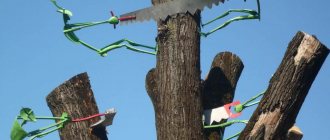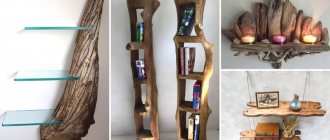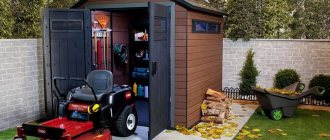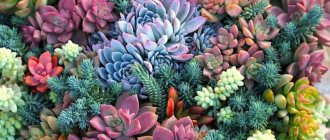Succulents are plants that are able to accumulate liquid in their own leaves and stems. Quite often they can be found in the wild in dry places. They can go without watering for a long time, as they receive nutrients from accumulated moisture. Succulents are a category of plants belonging to different families, having different chemical compositions and botanical descriptions, and also differing in appearance. They are united only by similar conditions of existence.
Succulents for open ground
All types of succulents have various devices on the surface of their leaves or stems with which they retain moisture. So, according to the method of moisture accumulation, these plants are divided into two varieties. Stem - moisture accumulates inside the stems, thereby causing them to expand and thicken in the form of a ball or bottle. Leafy species accumulate moisture only in the leaves.
Spurge
Euphorbia is native to northern Africa and is widely used as an ornamental and medicinal plant. It contains a specific milky juice that can irritate the skin. The inflorescence has leaf wrappers with a specific yellow-green color. There are species with red and yellow flowers. Plants tolerate both direct sunlight and partial shade. The genus Euphorbia contains about two thousand species, which are represented by perennial herbs and shrubs. Some of them are poisonous.
Euphorbia Mile
Rejuvenated
It is a perennial groundcover plant that is capable of forming an oval and spherical rosette of dense consistency. The leaves of Molodilo are quite fleshy, oblong or ovoid in shape. From the base of the rosette of the plant there are many stolons, which contain daughter rosettes. Peduncles are formed 14-15 cm long with small thyroid-shaped inflorescences of white, pink and red colors. The succulent blooms during June and July, after which the rosette dies off completely. Juvenile is characterized as a cold-resistant and drought-resistant plant that requires sufficient sunlight. Ideal for growing in group compositions or alone in containers and borders in garden beds.
Sedum
A perennial succulent with fleshy leaves and star-shaped flowers, which are collected in umbellate or corymbose inflorescences. Due to its unpretentiousness to the weather and climatic conditions of the growing area, it has become widespread on all continents. The leaves have a flat structure and a cylindrical shape. The arrangement of leaves on the stem is regular. Sepals and petals completely free at the base. Sedum has a very beautiful decorative form. The length of the stamens is twice the length of the petals. There are many species with high winter hardiness, so feel free to plant these succulents in your dacha.
Sedum succulent – Saxifraga
Levisia
A low herbaceous perennial plant. Levisia's leaves are elongated-ovate with wavy edges. The leaves are quite thick and dark green in color. The flowers of the succulent form a few-flowered inflorescence up to 4 cm in diameter. The flower petals are pink or pinkish-lilac with light edges and barely noticeable thin longitudinal stripes.
Bacopa
A sun-loving plant that is unpretentious to the soil. The stems are quite thin with a tendency to lodging. The leaves are very small, ovate and broadly elliptical in shape. The leaf color is green or olive green. The leaf margins have jagged edges. Flowering occurs throughout the summer. The flowers are small, tubular and bell-shaped. The perianth consists of 4 or 5 symmetrical lobes of white, blue or light blue. It is characterized by weak winter hardiness and tolerance to waterlogging of the soil, so such succulents in the country must be prepared for winter. Propagated by cuttings. In summer it is used for landscaping various reservoirs, and in winter it is perfect for use in aquariums.
Ragwort
The ragwort includes various forms: trees, vines, herbaceous plants. The inflorescence of a succulent is a basket that is similar to a dandelion or chamomile. After flowering, flying seeds quickly form in the inflorescence. Raspberry is distinguished by its unpretentiousness in cultivation. Prefers well-lit places and needs several feedings. Propagated by seeds and cuttings. Raspberry plants cannot withstand severe waterlogging of the root layer. Therefore, when growing in the garden, it is worthwhile to carefully choose a place for planting Raspberry.
Meadow cruciferous
Delosperma
This plant is native to southern Africa. In nature, there are more than a hundred species of this plant, which can be ground-covering plants or subshrubs. Very often, delosperma is grown indoors. The above-ground part of the plant is capable of growing strongly in length up to 30 cm. The stems branch quite strongly and bend easily to the ground. The root system of delosperma is highly branched and fleshy in shape. The leaves are lanceolate-shaped, curved, reaching a thickness of 3-4 mm. The aerial part is dark green and bluish. The surface of the green parts very often forms crystals of potassium salts.
Apthenia
The natural condition for the growth of Aptenia is dry subtropics or semi-deserts. On the territory of our country there are four species, low-growing with tetrahedral stems and fleshy leaves. Peduncles form on the tops of the lateral branches and in the axils of the leaves. Aptenia is very demanding of sunlight. The best way to grow a succulent is as a houseplant. In this case, it is necessary to plant in a loose grain mixture with good drainage. Propagated by stem cuttings throughout the spring.
Rejuvenated (stone rose)
Young people are endowed with mystical abilities to ward off evil spirits and neutralize negative energy.
Be that as it may, this plant deserves the attention of novice gardeners due to its unpretentiousness and variety of species.
During the flowering period, a stem covered with leaves grows from the middle of each adult rose. It is crowned with a small but brightly colored flower - the shade depends on the type and variety.
Young Reginae-Amaliae
It is the most rose-like of its species. The succulent leaves-petals have a soft green color, which in the sun can acquire a bright orange edging. Its rosettes are compact and most suitable as the main background plant in a composition of relatives.
Young Brunette
This type is more like a green crystal with a dark red tint. This is a fairly large specimen in its form; it looks great against the background of smaller juveniles and creeping sedums.
Roofing was young
This is the most frost-resistant species, because it has to survive in the conditions of a green roof, where the soil freezes through in winter. Nevertheless, bright green roses with flat petals are a welcome guest both on an alpine hill and in a modular flower garden.
Young Octopodes
It looks like charming balls with dark red petal tips.
When propagating, short branches with miniature balls at the end emerge from under the rosette - these are babies that quickly take root as soon as they land on the ground.
Hybrid youth Fame
It boasts an unusual leaf color. There are soft green, yellow, light pink shades here.
A composition of this species alone is a self-sufficient decoration of a small piece of land, and if you correctly highlight it with monochromatic green relatives, a bright color effect is guaranteed!
Juvenile Soboliferum (runner)
Soboliferum is distinguished by a small diameter rosette and a very dense planting of short leaves.
Before flowering, an adult rose produces a leafy stem up to 25 cm high, which in June-August is crowned with inflorescences of large yellow flowers. Its children, unlike the adult plant, have a crimson tint to the outer leaves.
Caring for succulents in the garden
In order for succulents to reveal their potential and be able to properly decorate the territory of the dacha, it is necessary to carry out a range of measures aimed at creating optimal conditions for the growth and development of these plants. At the same time, ignoring even one factor can lead to a slowdown in plant development or to their complete death.
Location and lighting
When growing succulents in a summer cottage, you need to be very scrupulous in choosing a growing location. Almost all species need sufficient sunlight throughout the day. Even slight shading can cause a decrease in growth activity. Therefore, you should choose a place on a site without nearby tall trees or various buildings. If succulents are grown as indoor plants, they should be placed on south-facing windows or artificial lighting should be used.
What soil is needed for succulents?
Succulents are not demanding on soil fertility. Therefore, they grow normally even on sandy soils. However, it is better to use more fertile soil for planting, as this will avoid several fertilizing and quite frequent loosening of the surface layer.
When choosing a growing location, you should not forget about the acidity of the soil, which has its own optimal indicator for each succulent. In addition to soil fertility, it is necessary to take into account its density. Indeed, in highly compacted soils, the root system develops slowly, which negatively affects the development of the entire plant.
An important soil indicator for succulents is humidity. Due to the fact that succulents do not tolerate prolonged waterlogging of the soil, it is necessary that groundwater does not approach closer than 1.5 m to the surface of the earth. When growing succulents as indoor plants or in containers, it is necessary to have a drainage layer below the soil. Therefore, we can say that succulents prefer soils of average fertility with good drainage ability and optimal soil acidity.
How to water succulents in the country and what to feed them with
Succulents are characterized by high drought resistance. In addition, the plants have a fairly powerful root system that is capable of taking water from the lower soil horizons. Therefore, when you grow succulents in the country, the plant does not need regular watering. Only during a very long dry period can one water-recharging irrigation be carried out per season.
It is advisable to fertilize at least three times per season. But for this it is necessary to use exclusively mineral fertilizers.
The use of organic matter has a negative impact on plant development.
It is best to feed succulents using solutions of liquid fertilizers, such as Vympel (12-14 ml per 10 liters of water) or Energen Aqua (11-13 ml per 10 liters of water). The first feeding is carried out at the beginning of the growing season, and the second before flowering begins. The third feeding is needed by plants in the autumn before going into winter.
How to grow Lithops at home?
This variety of succulents is considered very rare. She is very high maintenance. The plant is an oval element that bears some resemblance to a pebble.
During flowering, a small peduncle forms inside the stem. The flower evenly covers the fleshy base and has a pleasant smell.
As for the color palette, depending on the Lithops variety, it can be a bright purple hue or a pale yellow color.
Diseases and pests of succulents
The greatest damage to succulents is caused by fungal diseases such as fusarium and late blight. Fusarium affects the roots and gradually affects the entire above-ground part. The main symptom of the disease is stunting of growth and coloration of the plant in a pale gray color. To combat the disease, it is necessary to spray the plants with Fitosporin-M or Fitolavin.
Late blight primarily affects the root collar and subsequently damages the leaves and stems of plants. A sign of plant damage by late blight is the appearance of brown spots. To cure the affected plants, you need to treat the plants with fungicides Ridomil Gold, Horus.
Late blight on succulents
The most harmful pests are aphids and spider mites. Aphids are quickly able to create large colonies, which are located on the lower part of the leaf. These small pests feed on cell sap by sucking the curls of plant leaves. You need to fight aphids using insecticides BI-58N, Karbofos and Metafos.
Spider mites are located, like aphids, on the lower part of the leaf. The mite feeds on plant sap and a growth forms at the site of damage to leaf tissue. If the tick has multiplied greatly, then at the site of its accumulation you can see a white cobweb. To destroy mites, you need to spray plants with the insecticide Karbofos.
Argyroderma or "flowers of life"
This name translated means silver base. The plant is a round succulent with a bluish tint.
The surface of the flower is smooth.
The leaves are made in the form of small spines with soft pile around the entire perimeter. Short peduncles with a bright bud inside are formed in the center of the flower. Outwardly, it resembles a garden aster flower.
Organization of watering
Excess moisture can cause root rot, and therefore the frequency of watering should be reduced to 2 times every 7 days in the summer, and to 2 times a month in the winter.
Plant needs for additional liquid can be assessed by the condition of the stem or leaves (for stem and leaf succulents).
Reproduction
Young plants
You can propagate succulents in 4 ways:
Seeds Required conditions:
- Planting material must be fresh. They need to be washed before planting.
- The substrate is sand and peat. Before planting, it must be disinfected by calcining it in the oven.
- The pot must have drainage holes
A drainage layer is placed at the bottom of the pot, and soil is poured on top . Before planting, it must be moistened by placing it in a tray with water. Next, you can sow the seeds.
Maintain the temperature around 22 degrees. Before the emergence of seedlings, sharp jumps should not be allowed. Plant shoots begin to appear after 20 days. You may have to wait longer, depending on the quality of the seeds.
The plant should be replanted no earlier than after 6 months. After diving, young succulents need to be shaded. This will help them quickly adapt to new conditions.
Cuttings To plant a new plant, the cuttings must be healthy and undamaged. After the cut, you need to put it on the window so that the cut can air for 2 - 3 days. Then it is planted in a pot.
Do not place succulent cuttings in water. They will begin to rot in it and will not take root.
The stems and leaves take root in about 14 days. You need to water regularly as the substrate dries out.
Leaf The leaf of the plant should be placed in a pot with loosened soil. Lightly press it into the ground. Next, leave it for two weeks. It will take root on its own and give birth to children.
Types of succulents that can be propagated from leaves. These include:
- Crassula
- Kalanchoe
- Sedum
- Pachyphytum
Vegetatively Some succulents grow babies on their leaves, already with roots, for example, Kalanchoe. All that remains is to collect them and plant them in the soil.
Other types of plants produce babies, for example, haworthia and aloe . They are carefully separated from the mother plant and planted.
Creeping varieties of succulents, such as delosperma, can be propagated by layering. The stem of the plant is dug in, after the roots appear, it is separated and transplanted into a separate pot.
What is Haworthia?
This variety of succulents is distinguished by its fleshy leaves, the edges of which have pointed bases. There may be small white thorns around the perimeter of the plant.
The length of the leaf plates reaches 10 cm. Many gardeners fell in love with it for its decorative coloring and unusual leaf shape. Outwardly, they resemble cuttlefish.
Setting up lighting in the room
Caring for succulents begins with proper organization of daylight hours. All known plant species love the sun very much. All flower pots should be placed on a south-facing window for sufficient sunlight.
But it is worth remembering that aloe and crassula must be hidden in the shade during the lunch period. Between November and March, plants will need additional lighting (using a fluorescent lamp). To ensure normal growth and photosynthesis, the duration of daylight should be at least 12 hours.
“Tree of Happiness” or Crassula succulent
This type of succulent is found in every apartment. Some gardeners call it the “money tree.” The round leaves are dense to the touch and resemble neat coins.
According to the legend of some gardeners, this plant is considered a real amulet for attracting financial wealth. The more magnificent its crown, the more money there will be in the house. However, this is just a superstition that was invented by amateur flower growers themselves.
The height of an adult plant can reach up to 80 cm, and the width of the bush up to 50 cm. The base of the succulent is presented in the form of a powerful trunk, the diameter of which can reach 8 cm.
As for care and cultivation, the plant is quite unpretentious for keeping at home. To do this, just place the pot with the plant on the south side. Watering should be done once a week.
Climate control
Succulents are true desert dwellers and therefore prefer dry air. Plants do not require additional spraying. Regular ventilation of the room will help reduce the humidity in the room.
Due to the peculiarities of their structure, all known varieties tolerate sudden temperature changes, and slowing growth in winter is a natural physiological process.











